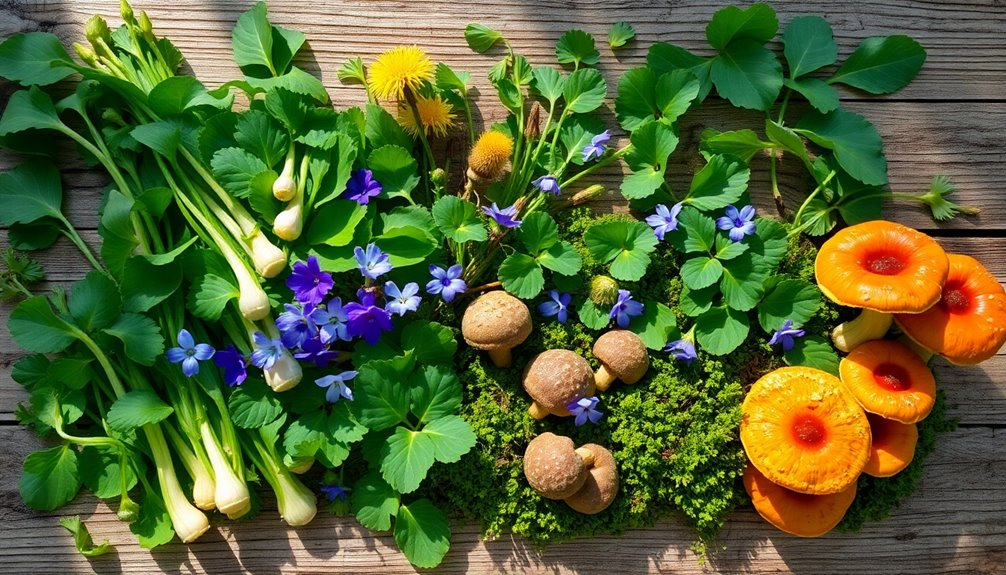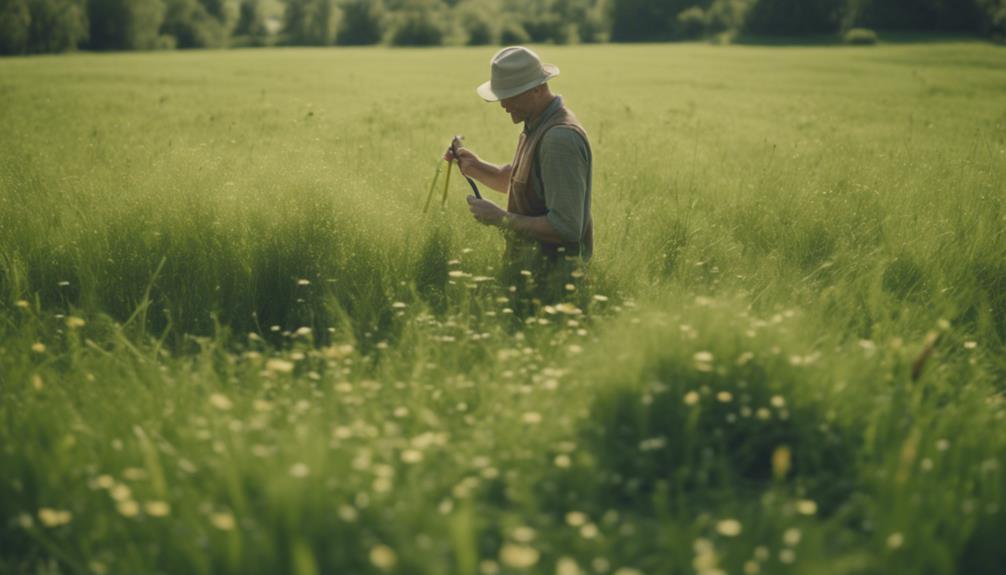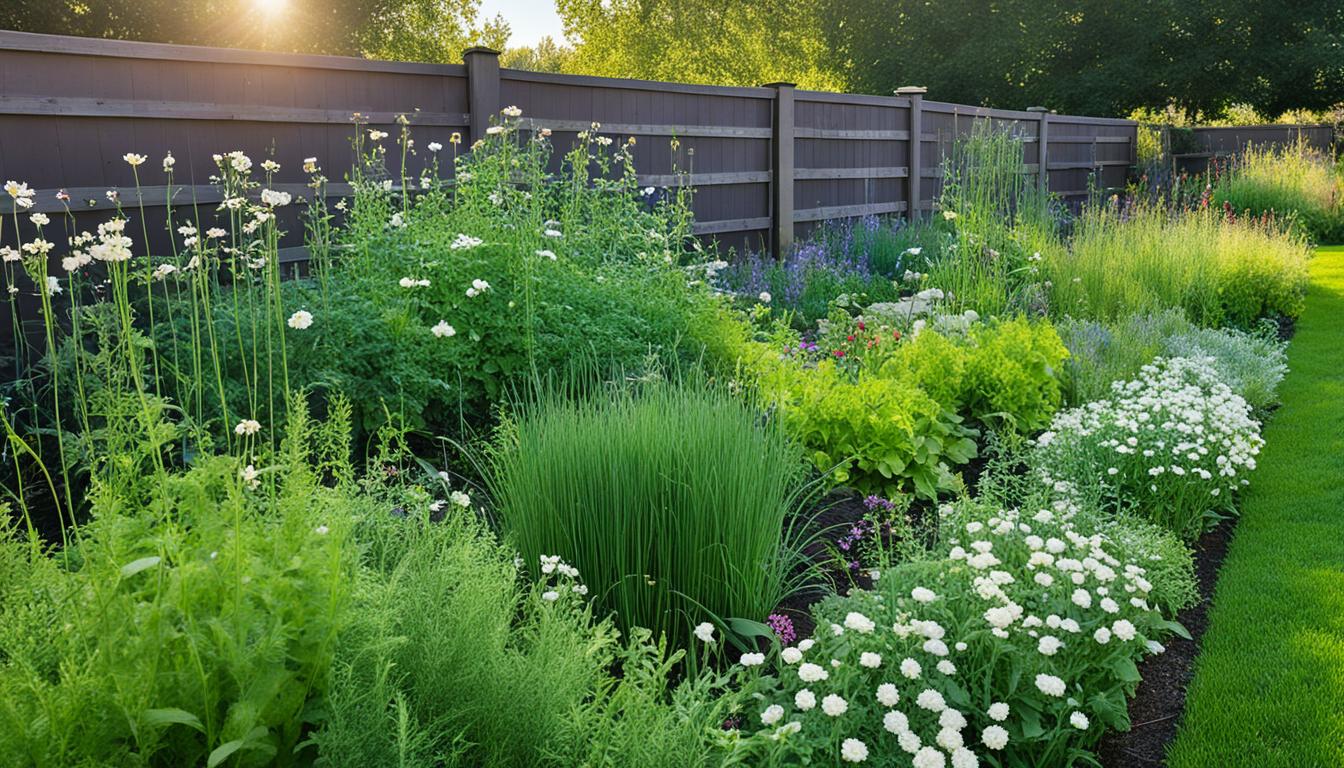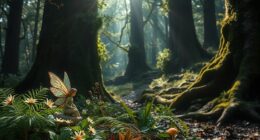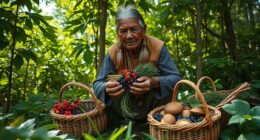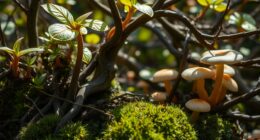In April, you can discover a bounty of wild edibles just waiting to be foraged. Look for vibrant wild garlic, nutritious nettles, and cheerful dandelions. These plants not only pack a flavorful punch but also offer numerous health benefits, like high vitamins and antioxidants. When you hit the trails, bring a sturdy backpack, gloves, and a pocket-sized foraging guide to help identify these treasures. Try foraging in the early morning or late afternoon for the freshest finds. If you're enthusiastic to find out more about techniques and tasty recipes, there's much more to explore!
Key Takeaways
- Forage for wild garlic, nettles, and dandelions in April, as they are abundant during early spring.
- Young Wood Violet leaves and chickweed are also great finds, adding color and flavor to dishes.
- Look for fiddleheads, which are tender young fern shoots best harvested before they unfurl.
- Prioritize sustainable practices by taking only what you need and leaving roots intact for regrowth.
- Explore local foraging workshops and community groups to enhance your skills and knowledge.
Prime Foraging Locations in April
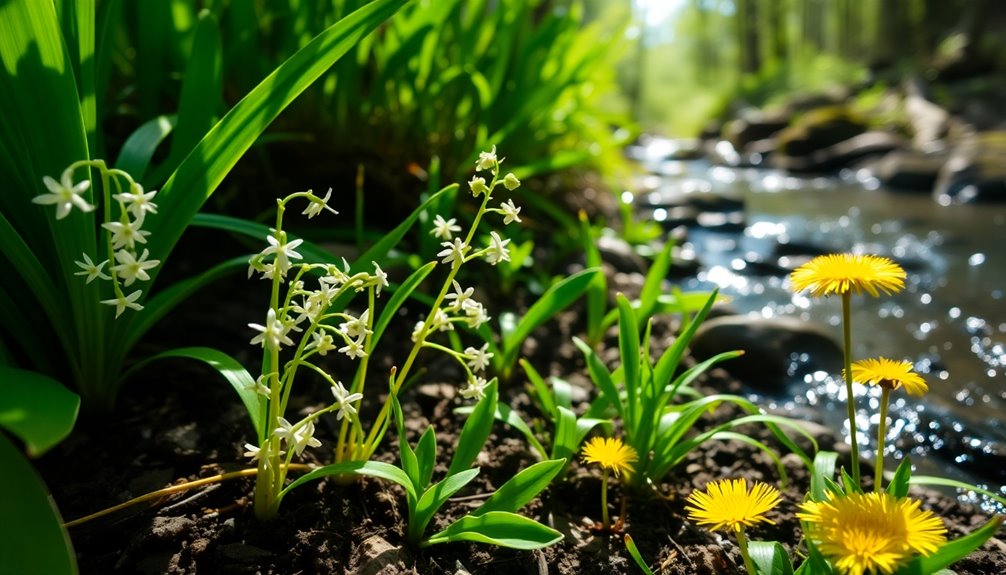
When you're looking for prime foraging locations in April, West Stow Country Park stands out as a top choice. This beautiful park not only features diverse plant life but also provides a stunning backdrop of West Stow Lake, a haven for geese.
As you explore, you'll discover a wealth of wild edibles like wild garlic, nettles, and dandelions, all thriving in early spring.
April is an ideal time for foraging, as these plants emerge in abundance. To make the most of your foraging experience, consider visiting in the early morning or late afternoon when the plants are at their freshest. Be mindful of the weather, as rain and temperature can greatly impact growth.
Engaging with local foraging communities is essential for honing your plant identification skills. They can provide valuable insights on specific locations and the seasonal availability of various edible species.
With this knowledge, you can navigate the park confidently, ensuring a successful foraging adventure. So gear up, head to West Stow Country Park, and enjoy the bountiful early spring greens waiting to be discovered!
Essential Foraging Tools and Gear
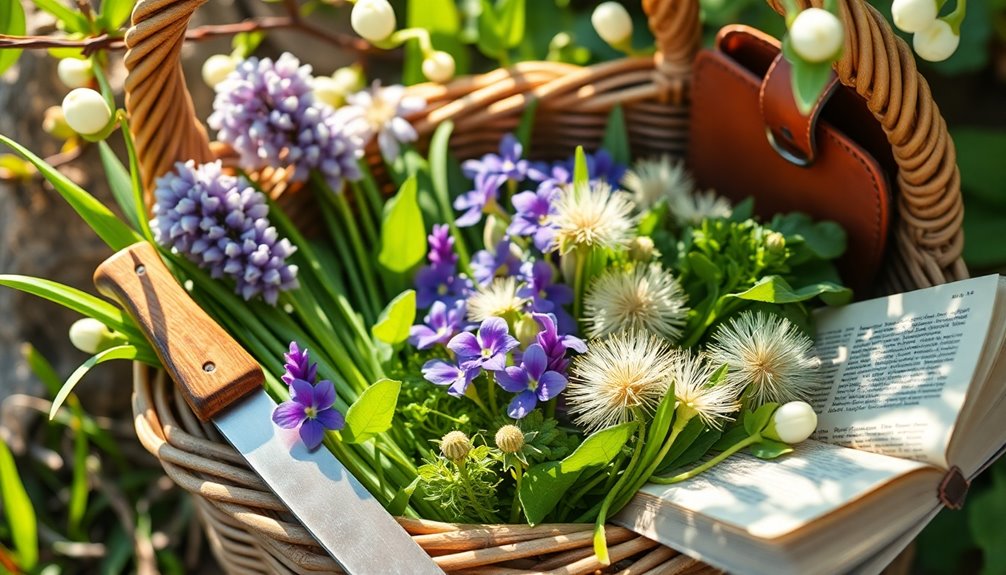
When you head out foraging, having the right gear can make all the difference. A sturdy backpack, a sharp knife, and a reliable foraging guide are must-haves that guarantee you gather safely and efficiently.
Plus, being mindful of sustainable harvesting practices will help you enjoy nature while preserving it for future foragers.
Must-Have Foraging Gear
Having the right gear can make all the difference during your foraging adventures. Start with a sturdy backpack to comfortably carry your collected finds and personal supplies. It's essential for long outings, ensuring you're prepared for whatever nature throws your way.
To keep your foraged plants fresh and organized, pack some Ziplock bags or breathable fabric bags to prevent moisture buildup and spoilage.
A pocket-sized foraging book is invaluable for quick references on plant identification and uses. This handy guide helps you make informed decisions about what to collect.
Don't forget your gloves; they protect your hands while handling potentially prickly or toxic plants, enhancing safety during your foraging.
Finally, bring along a notebook to jot down observations, locations of your finds, and even recipes for later. This practice not only improves your foraging skills but also helps you track your progress over time.
With these must-have items in tow, you'll be well-equipped to explore the seasonal bounty that April has to offer. Happy foraging!
Sustainable Harvesting Practices
Foragers must prioritize sustainable harvesting practices to guarantee the longevity of wild plant populations. When you venture out to gather wild herbs and wild greens, always remember to harvest responsibly.
Start by carrying a sturdy backpack and reusable ziplock bags to keep your foraged items fresh and organized. A basket is also a great choice, as it allows for better airflow, reducing spoilage and encouraging sustainability.
Don't forget to pack a pocket-sized foraging book. This essential tool helps you identify edible plants on the go, ensuring you avoid toxic look-alikes. As you hone your foraging skills, utilize a sharp knife and gloves for safe collection.
Keeping a notebook handy for recording your findings enhances your experience and promotes responsible practices. Additionally, understanding the importance of sustainable practices can help ensure that future generations can also enjoy the bounty of nature.
Lastly, practice slow walking while foraging. This technique allows you to thoroughly observe your surroundings, making it easier to spot edible plants and ensuring you only take what you need.
Identifying Spring Edibles
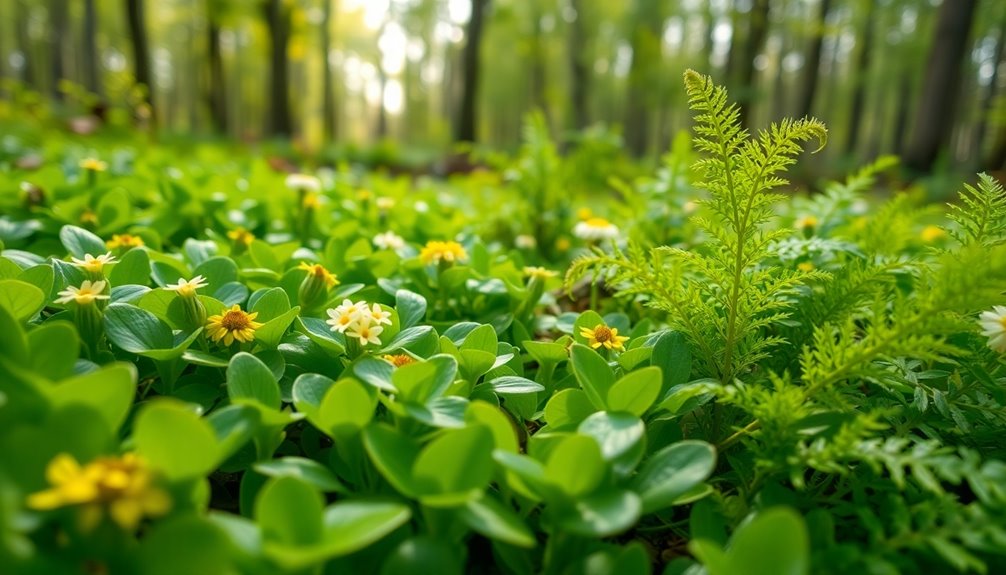
As you explore the spring landscape, knowing how to identify key edible plants is essential.
Look for the jagged leaves and bright yellow flowers of dandelions or the distinctive heart-shaped leaves of wood sorrel.
A good foraging guide can help you recognize these plants and their unique flavors while steering clear of any toxic look-alikes.
Key Identification Features
When you're out foraging in April, knowing how to identify spring edibles can make all the difference in your culinary adventures.
Start by looking for Young Wood Violet leaves, which are heart-shaped and can be purple, yellow, or white. They add a splash of color to salads with their edible leaves.
Next, you'll notice Wild Garlic; its broad, lance-shaped leaves emit a distinct onion-garlic scent, and both its leaves and flowers are delicious in dishes.
Keep an eye out for Fiddleheads, the coiled young fern shoots, especially from the ostrich fern. Their tightly curled tops signal that it's time to harvest them before they unfurl.
You can't miss Dandelions, recognizable by their jagged leaves and bright yellow flowers. Both parts are edible and perfect for salads or teas.
Finally, check for Chickweed, identified by its small white star-shaped flowers and opposite leaves. This mild-flavored wild plant thrives in moist areas and works well in pestos and salads.
Common Edible Plants
April brings a delightful array of common edible plants that can elevate your foraging experience. Among these, dandelions stand out with their vibrant leaves and flowers, both packed with nutrients. You can toss them into salads or brew them into an invigorating tea. Foraging baskets are an excellent way to collect these plants while ensuring they remain intact.
Next, look for young wood violets, which bloom in shades of purple, yellow, and white. These pretty wild greens not only add color but can also be candied for a unique dessert twist.
Don't overlook wild garlic; its strong onion-garlic scent makes it easy to identify. The edible leaves and flowers can enhance a variety of dishes, giving them a delightful flavor boost.
Another versatile option is dead nettle, which boasts a mild taste that works well in soups and salads.
Finally, keep an eye out for speedwell, often found in backyards and gardens. It's perfect for making herbal tea and adds a fresh note to your culinary creations. Additionally, be cautious when foraging, as certain plants like raisins for dogs can pose unexpected dangers if misidentified or misused.
Seasonal Foraging Tips
Foraging for spring edibles can be a rewarding adventure, especially with the abundance of fresh plants emerging this time of year. To help you identify these tasty treasures, keep an eye on key features like leaf shape, flower color, and growth patterns. A pocket-sized foraging book will be your best companion in the field.
Here are some tips for identifying spring edibles:
- Look for young wood violet leaves—they're often heart-shaped and delicious in salads.
- Spot dead nettle by its triangular leaves and purplish flowers; it's a nutritious addition to any dish.
- Dandelions are easy to recognize; their bright yellow flowers and lobed leaves are hard to miss.
- Chickweed has small, star-like flowers and is great in fresh salads or teas.
- Be cautious of toxic look-alikes like hemlock; always confirm your finds with multiple sources.
Remember to practice sustainable harvesting. Take only what you need and leave the roots intact to encourage regrowth.
Safety Tips for Foragers
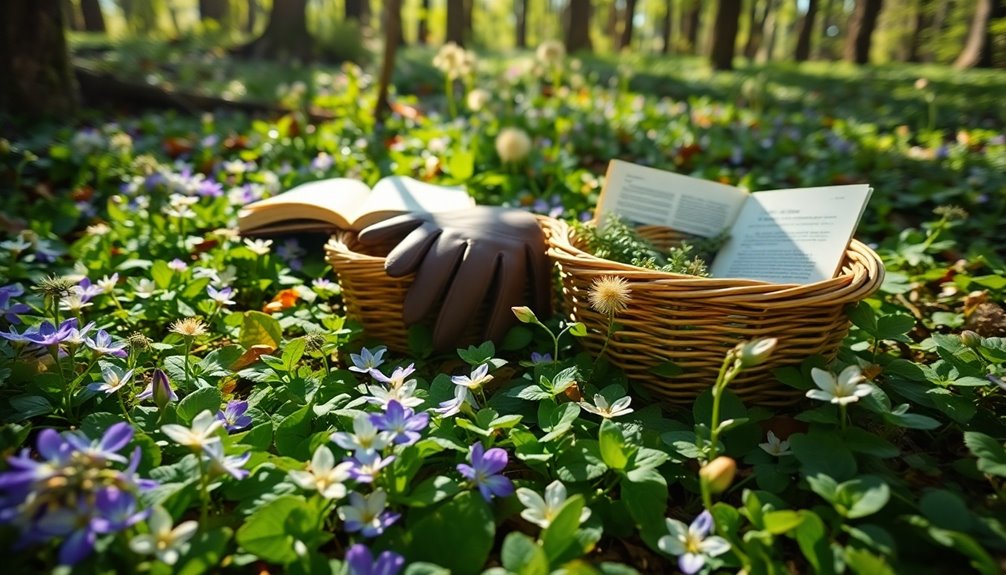
A solid knowledge of safety tips is vital for anyone venturing into the wild to forage. Always carry a pocket-sized foraging book or a reliable plant identification app. This helps confirm the edibility of any wild plants you encounter.
Familiarize yourself with common poisonous look-alikes, such as hemlock and lesser celandine, to avoid potentially harmful misidentifications.
When foraging, prioritize sustainable harvesting practices. Take only what you need and leave enough for plant growth, ensuring the health of local ecosystems.
It's essential to research local foraging laws and regulations. Compliance with any restrictions on foraging in public or protected areas will keep you safe and responsible.
Additionally, steer clear of areas that might be polluted or contaminated, like roadsides or industrial zones. These locations could harbor harmful substances that may affect the edibility of your finds.
Cooking With Foraged Ingredients
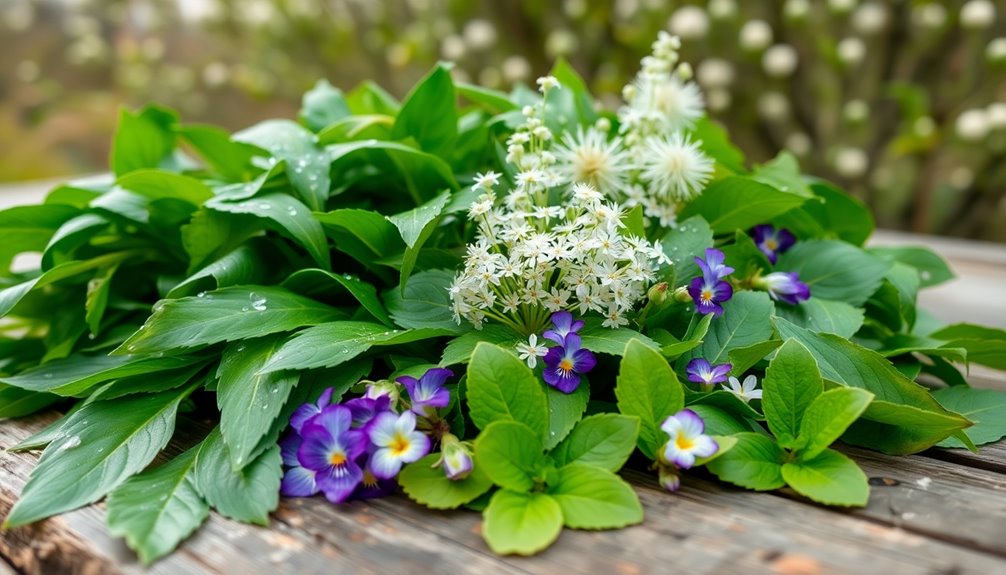
Cooking with foraged ingredients opens up a world of flavors and nutrition right from your backyard or local woods. Incorporating these unique finds into your meals not only enhances taste but also connects you to nature.
Here are some fantastic options to ponder:
- Wood Sorrel: Its tangy flavor makes it a delightful addition to salads or as a garnish for soups.
- Violet Leaves: These young leaves add color and a subtle flavor to salads, elevating your dish with a touch of elegance.
- Wild Ramps: Known for their strong onion-garlic scent, they're perfect for sautés or as a base for flavorful pesto.
- Fiddleheads: Rich in antioxidants, they can be blanched or sautéed to create a nutritious side dish or salad.
- Edible Flowers: Violets and other blooms not only beautify your plate but also offer delicate flavors in cookies, salads, and garnishes.
Additionally, foraging can enhance your meals with nutritional benefits that support overall health, similar to how certain foraged plants like fiddleheads provide essential nutrients. Experimenting with these ingredients can transform your cooking and inspire creativity.
Nutritional Benefits of Wild Foods
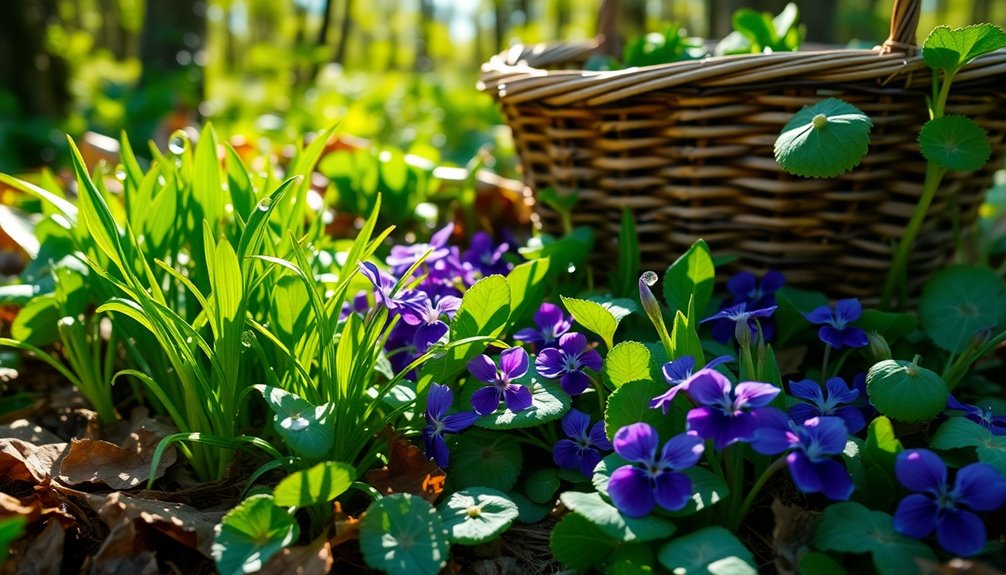
Exploring wild foods not only enhances your culinary repertoire but also offers a wealth of nutritional benefits. By incorporating edible wild plants into your diet, you can greatly boost your intake of essential vitamins and minerals. For instance, nettles, dandelions, and chickweed are often richer in vitamins A, C, and K compared to their cultivated counterparts.
Additionally, foraged plants like wild garlic and ramps have antimicrobial properties that can promote gut health and strengthen your immune system. Many wild edibles, including fiddleheads and violets, are high in antioxidants, which combat oxidative stress and may reduce the risk of chronic diseases. Regularly including high-fiber foods like these can further support digestive health and overall wellness.
Here's a quick overview of the nutritional benefits of some common wild foods:
| Wild Food | Nutritional Benefits |
|---|---|
| Nettles | High in vitamins A, C, and K |
| Dandelions | Rich in antioxidants and essential minerals |
| Ramps | Antimicrobial properties for gut health |
| Fiddleheads | High in antioxidants |
Incorporating wild foods into your meals enhances dietary diversity, introducing unique flavors and nutrients that are less common in conventional diets. Immerse yourself in foraging and elevate your health!
Sustainable Foraging Practices

Sustainable foraging practices are essential for preserving the delicate balance of our ecosystems while enjoying the bounty of nature.
By practicing responsible foraging, you can help guarantee that plant populations thrive for generations to come. Here are some key principles to follow:
- Take only what you need: Harvesting with restraint helps maintain healthy ecosystems.
- Leave roots intact: This encourages regrowth and supports the long-term health of plant species.
- Avoid overharvesting: Be mindful, especially in areas with rare or endangered plants, to protect biodiversity.
- Use proper harvesting techniques: Cut or pinch plants instead of uprooting them to minimize damage and promote regeneration.
- Join community foraging groups: Engaging with others can enhance your knowledge and foster a collective commitment to sustainable practices.
Community Engagement and Sharing
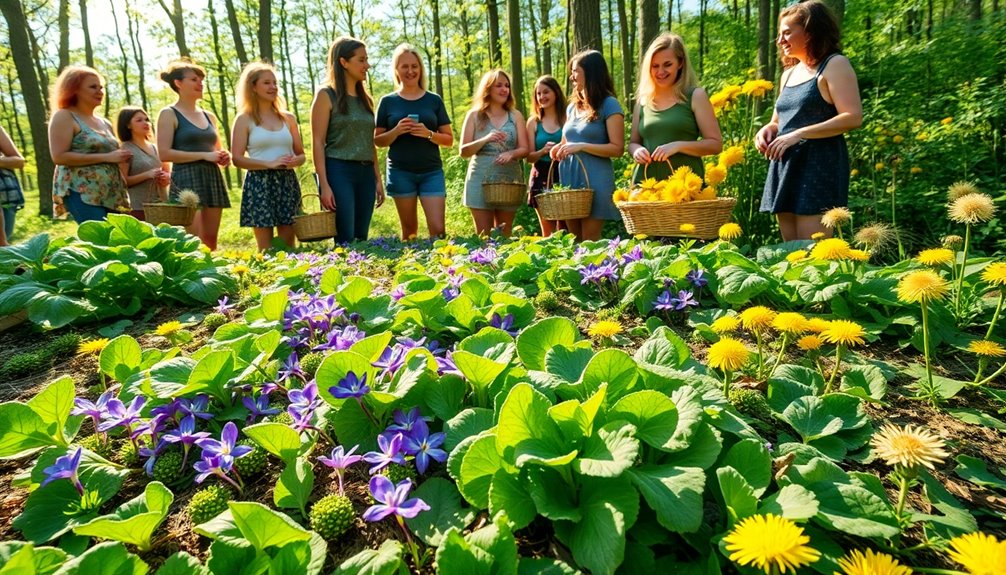
Engaging with your local foraging community can greatly enhance your experience and knowledge of wild edibles. It's an ideal time to connect with others who share your passion for exploring nature's bounty. By participating in workshops or events, you'll find information about local plants and meet fellow enthusiasts, fostering lovely things like collaboration and camaraderie.
Social media platforms, especially #ForageTok, allow you to showcase your discoveries and culinary creations, inspiring others to immerse themselves in the world of wild foods. Community sharing initiatives, such as potlucks featuring foraged dishes, introduce diverse flavors and highlight the nutritional benefits of wild ingredients. Additionally, building a harmonious co-parenting environment through shared experiences can create a supportive network that benefits all involved.
Here's a glimpse of what community engagement can look like:
| Activity | Benefits |
|---|---|
| Foraging Workshops | Learn identification and harvesting skills |
| Potluck Gatherings | Share recipes, enjoy new flavors |
| Online Forums | Exchange tips and experiences |
Involving yourself in these activities not only enriches your foraging journey but also creates lasting connections with others who appreciate the beauty of nature's offerings. So, gather your local foragers, and start sharing the joy of foraging!
Frequently Asked Questions
Is It Illegal to Forage in National Parks?
Yes, it's generally illegal to forage in national parks.
These areas are protected to preserve ecosystems and wildlife habitats. Each park has its own regulations, so you should check the specific guidelines before considering foraging. Collecting plants or mushrooms without permission can lead to fines.
However, some parks offer designated foraging programs or workshops, allowing you to learn about local flora responsibly while supporting conservation efforts.
Always respect the rules to protect the environment.
What Is the Number One Rule of Foraging?
The number one rule of foraging is to properly identify plants before you consume them.
You've got to be sure you can distinguish between edible species and their toxic look-alikes. Using multiple resources, like field guides or reputable apps, helps you verify what you find.
Also, knowing local poisonous plants is essential for your safety.
What to Avoid When Foraging?
When foraging, you should avoid plants that look similar to toxic varieties. Always identify what you're harvesting to prevent mistakes.
Stay away from polluted areas, as contaminants can harm your health. Be cautious with anything that may cause allergies or digestive issues, like certain wild legumes.
Finally, respect local laws regarding foraging; some plants are protected, and harvesting them could lead to legal consequences.
Always prioritize safety and sustainability in your foraging adventures.
What Is the Best Time to Forage?
Imagine wandering through a quiet forest at dawn, the world just waking up. That's the best time to forage!
Early morning or late afternoon is when plants are freshest and most vibrant. You'll find them at their peak, ready for the picking.
Keep an eye on your local climate, too; rain and temperature can change what's available.
Explore green spaces and nature preserves for the richest bounty, and enjoy your adventures!
Conclusion
As you venture into the wild this April, remember that foraging isn't just about gathering food; it's a way to reconnect with nature. Each leaf, flower, and root tells a story of resilience and abundance. By embracing sustainable practices, you're not only nourishing yourself but also preserving these treasures for future generations. The thrill of discovery brings a sense of fulfillment that store-bought simply can't match. So grab your gear, explore, and let the earth surprise you!

